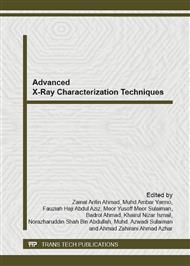p.268
p.273
p.278
p.284
p.289
p.295
p.299
p.304
p.309
Study on Effect Recyclability of Ru/Bentonite-TiO2 Catalysts in Glycerol Hydrogenolysis Reaction Using X-Ray Photoelectron Spectroscopy (XPS)
Abstract:
Recyclability effect on catalytic performance of Ru supported on the mixture of bentonite-TiO2 for the hydrogenolysis of glycerol was investigated under reaction condition of 150°C, 2.0 MPa hydrogen pressure and 7 h reaction time. Interestingly, the recovered Ru/bentonite-TiO2 catalyst was found to be active in the repeated runs. The conversion of glycerol increased in the four successive reactions as follows: 61.3%, 65.6%, 68.1% and 75.3%. This suggested that a sort of metal activation affect such as in situ reduction occurred during the repeated reaction. In order to confirm in situ reduction had occurred during the repeated reaction, XPS analysis of used catalyst after each reaction were carried out to study the chemical state of Ru 3d species. Narrow scan of peak Ru 3d revealed that intensity of Ru 3d5/2 peak at BE 280.0 eV which is corresponding to Ru0 species increased until three cycle reaction. This result confirmed that in situ reduction had occurred during the repeated reaction and this made the activities of the catalyst increased upon recycling due to the availability of more metallic Ru on the surface of the catalyst. This study also shows that conversion of glycerol increased linearly with the percentage atomic ratio of Ru metal active site available on the surface of catalyst.
Info:
Periodical:
Pages:
289-294
Citation:
Online since:
December 2012
Price:
Сopyright:
© 2013 Trans Tech Publications Ltd. All Rights Reserved
Share:
Citation:


